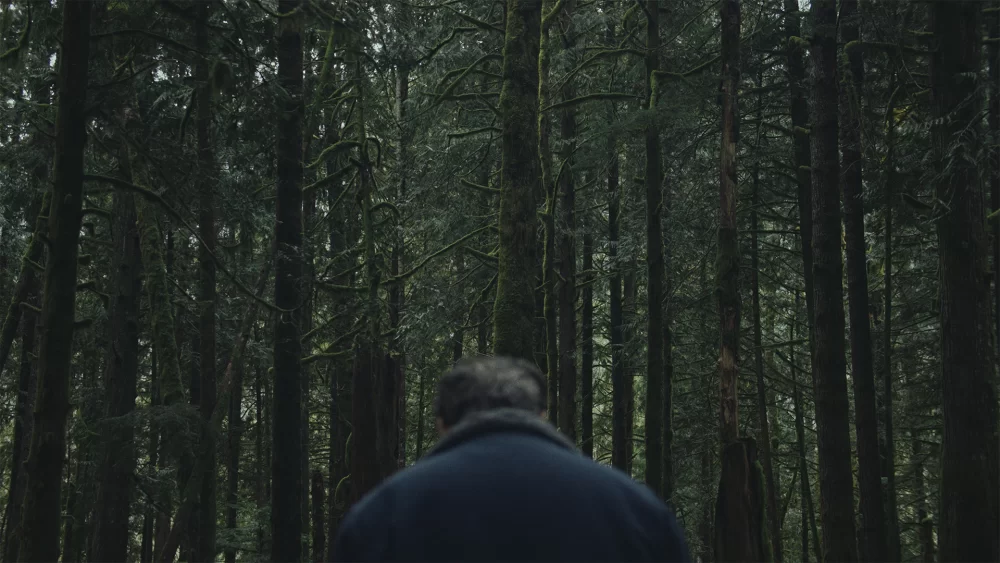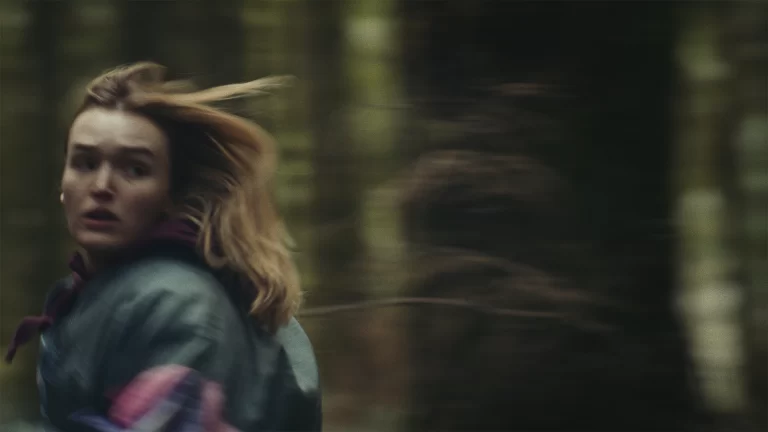Instead of a whimsical retelling, the film becomes a tense, atmospheric drama about trust, survival, and the scars left by past trauma. With striking cinematography, powerful performances, and a deliberate, slow-burning narrative, it’s an impressive debut from a filmmaker in complete command of her vision.
A Gritty Fairytale Set in the Oregon Wilderness
The film follows a reclusive woodsman (Ivan Martin) who discovers a teenage runaway, Dani (Maddison Brown), collapsed and half-frozen in the snowy Oregon wilderness. He brings her back to his cabin, reluctant to get involved but unable to leave her behind.
The two slowly build an uneasy companionship as the woodsman attempts to return Dani to her grandmother, which the latter insists upon doing. But much like the forests they move through, things aren’t as simple as they seem. Something about Dani’s story doesn’t quite add up: she seems to be running from something, and the deeper the film goes, the clearer it becomes that the true dangers aren’t always found in the wild.
Taylor leans heavily into the DNA of Little Red Riding Hood, but rather than retelling it outright, she twists its message. The biggest danger isn’t lurking in the woods—it’s waiting in the places we assume are safe. The film plays with audience expectations, hinting at familiar beats before shifting them in unexpected directions.
Through a non-linear structure divided into chapters (‘The Woodsman’, ‘Grandma’, ‘The Wolf’), “To Kill A Wolf” reveals its secrets in fragments. Some of these narrative choices work beautifully, keeping the tension simmering. Others, particularly in the second half, lead to pacing issues. The slow, deliberate setup gives way to a rushed conclusion, and some revelations feel a little too telegraphed by the time they arrive.
Performances That Elevate the Story
What really elevates the film, though, is the dynamic between the two leads, from which much of the film’s emotional weight comes. Martin and Brown bring depth to characters who could have easily been reduced to archetypes. As the woodsman, Martin delivers a quietly affecting performance as a man who has spent years keeping the world at arm’s length. A social outcast with his own share of scars, he is neither a hero nor a predator—just a man trying, in his own imperfect way, to do something good.
Brown, on the other hand, also impresses as Dani, portraying both defiance and vulnerability. Guarded yet vulnerable, Dani is not simply a victim but a person struggling to navigate a world that has repeatedly failed her. While some early scenes make her seem closed-off to the point of being emotionally distant, it becomes clear that this is intentional—Dani is someone who has learned not to trust easily. As her story unfolds, Brown finds the right balance between toughness and fragility.
Apart from Martin and Brown, the supporting cast is used sparingly but effectively. Michael Esper, in particular, leaves an impression as Dani’s uncle, bringing an unnerving, calculated presence that looms large even when he’s off-screen.
A Closer Look into the Reimagining of a Children’s Classic
As noted at the onset, Taylor’s take on Little Red Riding Hood isn’t just a surface-level reimagining—it’s an examination of what might have led to such a tale in the first place. The film strips away the folklore and instead presents something more unsettlingly real, where the concept of “the wolf” is far more complex than a single villain lurking in the woods.
Through the filmmaker’s lens, the wilderness becomes neither a place of safety nor immediate danger but a space where truths become harder to ignore. The fog-drenched pines and sprawling, untouched landscapes create a sense of eerie isolation, reinforcing the idea that both Dani and the woodsman are escaping something. However, the question of what, exactly, lingers ominously over much of the film.
As the story unfolds, the traditional fairy tale roles begin to blur. The woodsman, at first glance, seems to be Dani’s reluctant protector. But underneath the gruff, breviloquent bravado lies a man burdened by past mistakes, carving out a quiet existence on the fringes of society. Dani, meanwhile, isn’t the innocent, wide-eyed traveler in need of saving. Instead, she is guarded, withholding, and fully aware of the dangers that await her outside the woods.
Taylor plays with expectations, hinting at familiar beats before revealing the far more troubling reality at the movie’s core. The question isn’t just who the wolf is, but rather how danger can take many forms, often hiding in plain sight.

A Visual and Sonic Masterclass
To aid these thematic explorations as well as the performances, Adam Lee’s cinematography captures the Oregon wilderness with haunting precision, from the mist-heavy treetops to the decaying wood of the woodsman’s cabin. Lee’s camerawork boasts of such detail that you can almost smell the scenery and breathe in the muted color palette, which add to the film’s heavy, almost suffocating mood. It, in turn, makes you feel the chill in the air and the weight of the silence throughout.
The sound design and score add another layer of immersion. Composers Sara Barone and Forest Christenson craft a folk-inspired soundtrack that complements the film’s moody tone and heightens the eerie stillness without overpowering it. Every note feels carefully placed, enhancing the uneasy quiet that dominates much of the runtime. Working closely with her film scorers, Taylor clearly knows how to craft an atmosphere, and here, she does so masterfully.
Where the Storytelling Wobbles and Occasionally Stumbles
Taylor’s decision to structure the film in non-linear chapters—each labeled with fairytale archetypes mentioned above—serves as an interesting narrative framing technique. It works well in reinforcing the film’s themes and adds an extra layer of intrigue, but it’s also where some cracks begin to show.
While the fragmented storytelling keeps things mysterious early on, it also makes the timeline feel disjointed. For instance, flashbacks are essential to understanding Dani’s past, but the way Taylor introduces them here sometimes disrupts the flow rather than deepening the mystery.
The pacing is another issue. The first half moves with slow, deliberate pacing, immersing us in the characters’ fragile dynamic. This meditative approach allows the characters to breathe. But once the pieces start falling into place, the second half sees the film accelerating toward a conclusion that feels somewhat rushed, sacrificing some of the emotional weight it so carefully built. There’s also a sense that once the film lays its cards on the table—particularly regarding Dani’s family situation—the surprises start to dwindle.
Additionally, while “To Kill A Wolf” is thematically rich, some of its symbolism—like the connection between the woodsman’s past injury and the wolves he tries to save—is laid on a little thick. For what it’s worth, the film works best when it trusts its audience to connect the dots without over-explaining them.
‘To Kill A Wolf’: A Strong, If Imperfect, Debut
Despite all these, “To Kill A Wolf” never loses sight of its emotional core. It remains a striking, atmospheric film about people trying to claw their way out of the past, about the kind of wounds that don’t heal easily. It explores abandonment, abuse, and the ways in which human connection, even in its most unlikely forms, can be both a burden and a salvation.
Kelsey Taylor proves herself a promising director with a strong visual eye and a thoughtful approach to storytelling. While the film’s pacing stumbles and some narrative choices don’t entirely land, she approaches these themes with restraint, refusing to lean into melodrama, and that’s what makes the film resonate.
Ultimately, “To Kill A Wolf” isn’t the most unpredictable story, and once its twists become clear, some of its impact fades. But it succeeds where it matters most—drawing viewers into a haunting world where trust is fragile, danger isn’t always obvious, and redemption is never simple.

“To Kill A Wolf” will screen in the “Festival Circuit Favorites” at this year’s Santa Barbara International Film Festival, which runs from February 4 to 15, 2025. Follow us for more coverage.


